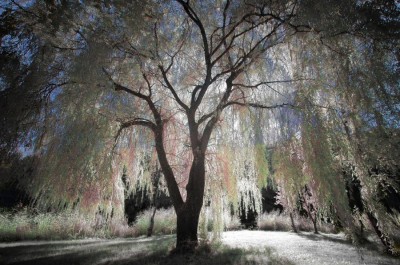There is no doubt the willow tree presents inspiration. This particular photo is breathtaking. Weeping willow trees always remind me of home. Growing up in the suburbs of Philadelphia, there was no lacking of trees. Our neighbors planted a willow tree along the shared drive. Long weeping branches and beautiful deep blue-green leaves, it was a site to behold.

The Colors of Claude Monet - By Licht courtesy pixdaus.com
During World War I, Claude Monet painted a series of weeping willow trees honoring the French fallen soldiers. In addition to his son Michel serving in the army, Monet’s friendship and admiration for Clemenceau the leader of France at the time, resulted in these beautiful paintings. In 1923, he underwent two cataract operations. Rumor has it that the surgery allowed for viewing ultraviolet wavelengths of light normally excluded by the lens of the eye, thus affecting his color perceptions. It is also said that repainting occurred after his operations.
Willow trees are native to China and very common in the Northeastern US. There are over 400 species of willow trees. The Green Weeping Willow is the one I knew as a child. Oftentimes their leaves truly do appear to be a bluish shade of green. Willows grow best in zones four to eight, thus the popularity in the northeast. Willow trees are commonly planted to provide shade, able to grow up to 50 feet tall. These fast growing trees can withstand bitter winter temperatures as well.
The beautiful photograph has inspired me much like they did for Monet. A weeping willow tree would be gorgeous in my yard not to mention the shade factor. This intention will first require professional advice from TyTy of Georgia, as we are on the edge of the recommended zones *sigh* and my intentions may be squelched by that fact.



What a lovely post and stunning photo. It took me back to my youth in the Northeast where I too marveled at the weeping willows, so grand. So you are in Georgia? I’m in Atlanta and while we have loads of foliage I miss the willows! Thanks for evoking a nice memory
No I’m not in Georgia, I’m in Florida. Very different here, tropical foliage. Quite different from the northeast! Thanks for stopping by.